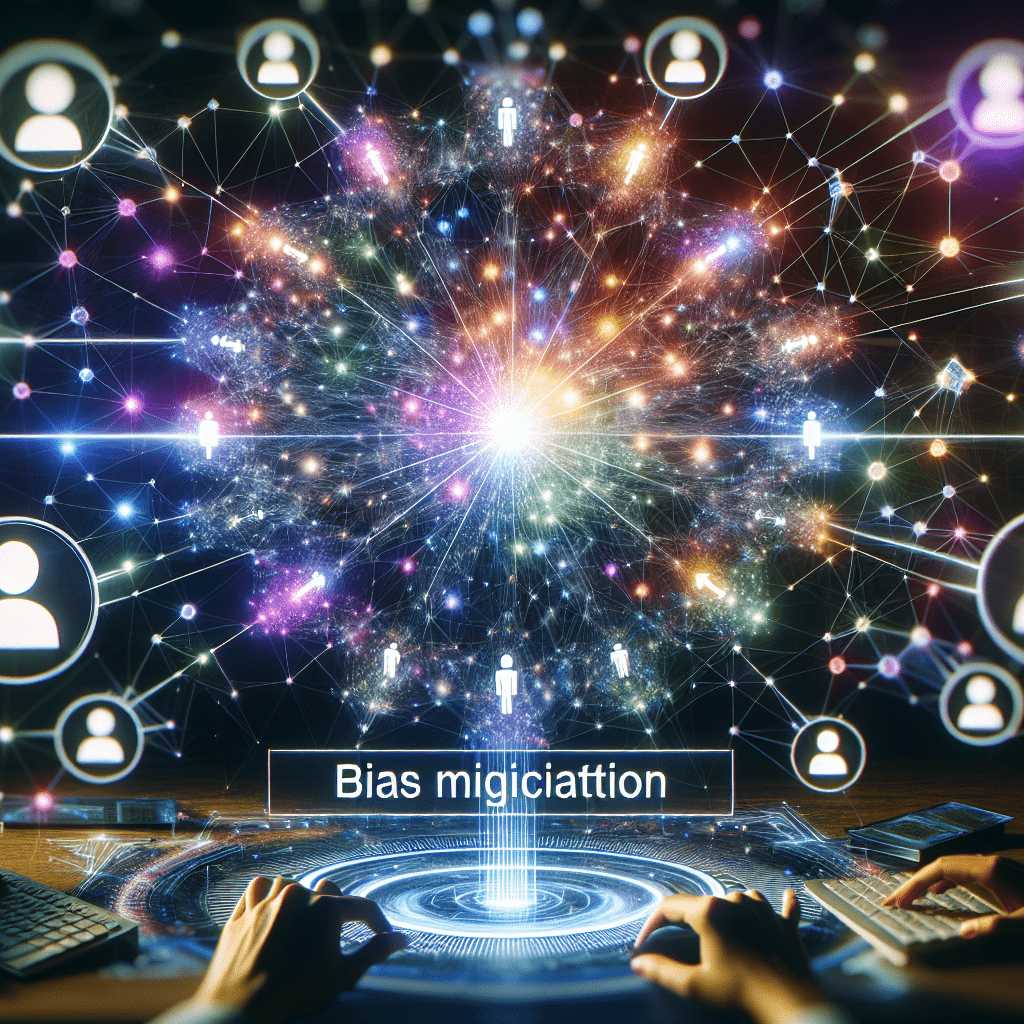In the fascinating world of virtual assistants, bias mitigation in decision-making algorithms plays a crucial role. These highly intelligent and interactive AI-powered entities have the ability to assist us in various tasks, serving as reliable companions in our daily lives. However, as technology continues to advance, it is essential to address the issue of bias within these algorithms. By understanding the impact of biases and implementing effective mitigation strategies, we can ensure that our virtual assistants provide fair and unbiased decisions, fostering inclusivity and equality for all users. Join us as we explore the ever-evolving landscape of bias mitigation in virtual assistant decision-making algorithms, where we strive to create a more just and equitable digital environment.
Introduction to Virtual Assistants
Virtual assistants have become an essential part of our daily lives, helping us with various tasks and providing us with information and guidance. These AI-powered technologies are designed to understand and assist with our needs, but have you ever wondered how they make decisions? In this article, we will explore the fascinating world of virtual assistants and delve into the importance of bias mitigation in their decision-making algorithms.

Definition of Virtual Assistants
Virtual assistants are AI-powered technologies that are designed to perform tasks and provide assistance to users. Utilizing natural language processing and machine learning algorithms, these virtual assistants can understand and respond to user queries and commands. They are capable of performing a wide range of tasks, such as setting reminders, sending messages, providing directions, recommending products, and even engaging in casual conversations. Examples of popular virtual assistants include Siri, Alexa, Google Assistant, and Cortana.
Types of Virtual Assistants
Virtual assistants can be categorized into two main types: voice-based and text-based. Voice-based virtual assistants, as the name suggests, rely on voice commands and responses for communication. They are commonly found in smart speakers, smartphones, and other voice-enabled devices. On the other hand, text-based virtual assistants rely on text input and output, making them suitable for messaging platforms and chatbots. Both types serve the same purpose of assisting users but utilize different communication methods.
Importance of Virtual Assistants in Decision-making
Virtual assistants play a vital role in decision-making, as they are often relied upon to provide information, recommendations, and even perform actions on behalf of the user. However, it is crucial to acknowledge that these decision-making processes are not immune to biases, which can have significant implications. Understanding bias in decision-making algorithms is essential to ensure fair and ethical outcomes for users.
Understanding Bias in Decision-making Algorithms
Definition of Bias
Bias refers to the systematic favoring or disfavoring of particular groups or individuals. In the context of decision-making algorithms, bias can arise from various sources, including the data used to train the algorithms and the design choices made during their development. While bias can be unintended, it can still lead to unfair outcomes and perpetuate inequalities.
Types of Bias in Algorithms
There are several types of bias that can occur in decision-making algorithms. One common type is algorithmic bias, where the algorithms themselves discriminate against certain groups or individuals. This can result from biased training data or biased design choices. Another type of bias is input bias, where biases in the data provided to the algorithms lead to biased outcomes. This can occur when the data used to train the algorithms is not representative of the diverse population it is meant to serve.
Impact of Bias in Virtual Assistant Decision-making
The impact of bias in virtual assistant decision-making can be significant. Biased algorithms can perpetuate inequalities, reinforce stereotypes, and limit opportunities for certain groups. For example, if a virtual assistant consistently recommends higher-priced products to users from specific demographic backgrounds, it could reinforce economic disparities. Bias can also affect the accuracy and reliability of information provided by virtual assistants, leading to misinformation or limited perspectives.
Ethical Concerns and Challenges
Potential Consequences of Biased Algorithms
Biased algorithms can have severe consequences for individuals and communities. They can lead to unfair treatment, discrimination, and the perpetuation of existing societal biases. For example, if a virtual assistant shows bias in job recommendations, it can contribute to a lack of diversity in employment opportunities. Biased algorithms can also impact access to resources and services, as certain groups may be excluded or disadvantaged based on algorithmic biases.
Fairness and Discrimination
Fairness is a crucial ethical concern when it comes to virtual assistant decision-making. Discrimination can occur when certain groups or individuals are unfairly favored or disadvantaged by the decisions made by virtual assistants. Ensuring fairness in decision-making algorithms is essential to promote equal opportunities and prevent discriminatory outcomes. It requires careful consideration of the underlying biases and the implementation of appropriate mitigation techniques.
Transparency and Accountability
Transparency and accountability are vital for establishing trust in virtual assistant decision-making. Users should be aware of how decisions are made and should have visibility into the factors that influence those decisions. Transparency can help identify biases and ensure that the decision-making processes are accountable and subject to scrutiny. This requires clear and accessible explanations of the algorithms used and the data sources involved.
Importance of Bias Mitigation
Unbiased Decision-making
The importance of bias mitigation in virtual assistant decision-making cannot be overstated. Unbiased decision-making is not only crucial for fairness and equal opportunities but also for the accuracy and reliability of information provided by virtual assistants. Mitigating bias ensures that the decisions made by virtual assistants are based on objective and unbiased criteria, leading to more reliable outcomes.

Enhancing User Trust
User trust is vital for the widespread adoption and acceptance of virtual assistants. If users perceive bias or unfairness in the decisions made by virtual assistants, their trust in these technologies may be compromised. By implementing bias mitigation techniques, virtual assistants can enhance user trust by demonstrating their commitment to fair and ethical decision-making. This can lead to increased user satisfaction and engagement.
Promoting Diversity and Inclusion
Another key benefit of bias mitigation in virtual assistant decision-making is the promotion of diversity and inclusion. By reducing biases, virtual assistants can facilitate equal opportunities and access to resources and services for individuals from diverse backgrounds. This can help overcome societal biases and promote a more inclusive and equitable society where everyone has a fair chance to succeed.
Bias Mitigation Techniques
Data Pre-processing
Data pre-processing involves cleaning and preparing the data used to train decision-making algorithms. It is an essential step in mitigating bias, as biased data can result in biased outcomes. Data pre-processing techniques include:
Identifying and Removing Biased Data
Biased data can perpetuate and amplify biases in decision-making algorithms. Identifying and removing biased data is crucial to ensure fair and unbiased outcomes. This can be done by carefully analyzing the data, identifying potential biases, and excluding or correcting the biased samples.
Augmenting Data with Diverse Sources
To ensure representativeness and inclusivity, data can be augmented with diverse sources. This can help overcome biases present in the original training data and provide a more comprehensive understanding of the diverse population the virtual assistant serves.
Ensuring Data Representativeness
Data representativeness is essential to mitigate bias. Ensuring that the training data accurately reflects the diversity and distribution of the user base can help reduce biases in decision-making algorithms. This can be achieved through careful data collection and sampling strategies.
Algorithmic Adjustments
Algorithmic adjustments involve modifying the algorithms themselves to mitigate bias. Different techniques can be employed to achieve this, including:
Fairness-aware Algorithm Design
Designing algorithms with fairness considerations in mind is an important approach to bias mitigation. Fairness-aware algorithm design aims to ensure that the decisions made by virtual assistants do not unfairly favor or disadvantage certain groups or individuals.
Regularization Techniques
Regularization techniques aim to control the influence of certain features or variables in decision-making algorithms. By adjusting the weights or penalties associated with specific features, regularization can help reduce the impact of potentially biased factors.
Parametric and Non-parametric Approaches
Parametric and non-parametric approaches involve adjusting the parameters or properties of the algorithms to mitigate bias. Parametric approaches require defining specific parameters, while non-parametric approaches adapt the algorithms based on the available data. Both approaches can help mitigate bias and promote fairer decision-making.
Human-in-the-Loop Approaches
Human-in-the-loop approaches involve involving human experts in the decision-making processes of virtual assistants. This can help mitigate bias and ensure fair outcomes. Human-in-the-loop techniques include:
Involving Human Experts in Decision-making
By involving human experts, decisions made by virtual assistants can be reviewed and validated for fairness and accuracy. Human experts can provide valuable insights and judgments that algorithms may not capture, helping to eliminate bias and ensure more equitable outcomes.
User Feedback and Iterative Improvements
User feedback is an invaluable resource for bias mitigation in virtual assistant decision-making. By actively soliciting user feedback and continuously improving the decision-making algorithms based on that feedback, virtual assistants can become more responsive to the diverse needs and perspectives of their users.
Bias Monitoring and Auditing
Regular monitoring and auditing of the decision-making algorithms can help identify and address biases. By analyzing the decisions made by virtual assistants, biases can be detected and appropriate mitigation measures can be implemented. This ongoing monitoring and auditing process ensures accountability and transparency.
Evaluating Bias Mitigation Techniques
Performance Metrics for Unbiased Decision-making
To evaluate the effectiveness of bias mitigation techniques, performance metrics need to be established. These metrics should assess the fairness, accuracy, and reliability of the decision-making algorithms. Evaluating the performance of virtual assistants in terms of unbiased decision-making can help identify areas for improvement and guide the selection and optimization of bias mitigation techniques.
Benchmarking and Comparative Analysis
Benchmarking and comparative analysis play a crucial role in evaluating the effectiveness of bias mitigation techniques. By comparing the performance of virtual assistants using different mitigation techniques, strengths and weaknesses can be identified. This can inform the development of best practices and serve as a basis for continuous improvement.
Real-world Implementation Challenges
Implementing bias mitigation techniques in real-world scenarios can present challenges. These challenges may include limited access to diverse and representative data, privacy concerns, and potential trade-offs between fairness and other objectives. Overcoming these challenges requires interdisciplinary collaboration, stakeholder engagement, and a commitment to ethical decision-making.
Case Studies: Bias Mitigation in Virtual Assistants
Applying Bias Mitigation Techniques in Popular Virtual Assistants
Several popular virtual assistants have implemented bias mitigation techniques to enhance their fairness and reliability. For example, Google Assistant has made efforts to reduce gender bias in voice recognition by providing more inclusive options and improving gender neutrality. Siri has also worked towards addressing biases and improving accuracy in its responses by involving human experts in decision-making.
User Feedback and Experience
User feedback plays a crucial role in the ongoing improvement of bias mitigation in virtual assistants. By actively seeking user feedback and incorporating it into the decision-making processes, virtual assistants can become more responsive and inclusive. User experiences and perspectives provide valuable insights that can help identify biases and inform the development of bias mitigation strategies.
Lessons Learned and Future Directions
Through case studies and user feedback, valuable lessons can be learned to guide the future development of bias mitigation techniques in virtual assistants. Continuous research, innovation, and collaboration are essential to refine and optimize these techniques, ultimately leading to fairer and more inclusive virtual assistant decision-making.
In conclusion, bias mitigation in virtual assistant decision-making algorithms is of utmost importance. By understanding and addressing biases, virtual assistants can provide fair and unbiased outcomes, enhance user trust, and promote diversity and inclusion. With continued research and collaboration, the future of virtual assistant decision-making holds the promise of equitable and ethical assistance for all.


